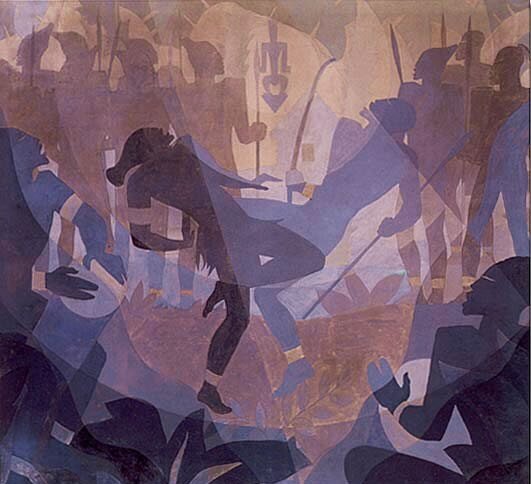Black Art & The Black American Experience
Aaron Douglas is among the first successful Black American artists to merge the African historical aesthetic with that of the Black American and gave generations of art lovers a visual reference, illustrating a relationship between Black Folks worldwide. Forged in fire, the Black American artistic experience is inseparable from the experiences of the people that provide us with these glimpses behind the curtain of their humanity. When you hear the soulful voice of Aretha Franklin, recognize that you are not hearing her simply hearing a woman singing love ballads. What you are witnessing is a long tradition of Black women’s artistic rendering of emotions that can’t be seen with the human eye, nor touched by the human hand. These are ethereal experiences that are intrinsic sensibilities tied to a people’s sojourn and transformation from one cultural container to another. The most essential parts of the Black American spirit are contained in the art that we produce, and one could easily argue that our spirituality also dances to these same rhythms. The feelings that these expressions solicit are undeniably tangible and exists across mediums, particularly in the visual arts. The level of emotion that would be generated at the sight of a painting or sculpture could be very similar to that generated when hearing a powerful musical piece. Aaron Douglas, being among the first artist to create a visual relationship between what was culturally, and what is. Creating this visual relationship was pure genius and emerged during a period where Black American’s were defining the historic legacy of this new cultural experience. Writers like J.A. Rogers, W.E.B. Dubois, Alain Locke, and others were on the front lines of defining what they then called the “New Negro” and what the ways in which art would be propagandized to ensure that a respected place in world history is secured for future generations to enjoy. In 1934 Aaron Douglas would paint a series of murals on a panel entitled, “Aspects of Negro Life”. These panels would illustrate the many ways that life would change for Africans in the diaspora, and provide a visual timeline beginning with the horrific moments leading up to the middle passage, and culminating with scenes in the then-modern world of the 1930s. Douglas would inspire generations of Black American artists to express the spirit of our collective experiences, and it can be argued that he was among a few artists in the early 20th century that opened the doors for artists to embody the spirit of the African aesthetic openly. How does this impact the rest of Black America?
The art produced by and for a particular group can influence how they see themselves. A visual artist's visual depiction can show people's potential and act as a spiritual map displaying what could eventually be. Douglas was very successful in creating cross-cultural relationships and awakening our innermost desire to embrace our identity on our terms. While teaching at Fisk University, Douglas was a strict teacher and had a great deal of emphasis that he would place on learning art “the hard way”. Douglas was an artistic fundamentalist that required his students to work with integrity and would never coddle his students. This strictness in the process and dedication to shifting the culture with his own works is why we today celebrate Aaron Douglas as one of the masters. Ultimately, Douglas proves in the early part of the 20th century that Black American art and the spirit of Black folks are inseparable. If a Black artist paints a portrait, a still life, or a Chokwe mask, they represent a long tradition of artists that fought through the bumps and bruises of oppression to exhibit the potential of Black excellence in the arts.



